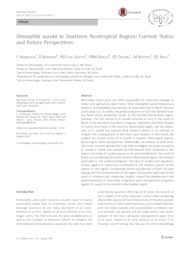Drosophila suzukii in Southern Neotropical Region: Current Status and Future Perspectives.
Drosophila suzukii in Southern Neotropical Region: Current Status and Future Perspectives.
Autoria: ANDREAZZA, F.; BERNARDI, D.; SANTOS, R. S. S. dos; GARCIA, F. R. M.; OLIVEIRA, E. E.; BOTTON, M.; NAVA, D. E.
Resumo: Non-native insect pests are often responsible for important damage to native and agricultural plant hosts. Since Drosophila suzukii Matsumura (Diptera: Drosophilidae) has become an important pest in North America and Europe (i.e., in 2008), the global production of soft thin-skinned fruits has faced severe production losses. In the southern Neotropical region, however, the first record of D. suzukii occurred in 2013 in the south of Brazil. It has also been recorded in Uruguay, Argentina, and Chile. Despite its recent occurrence in the southern Neotropical region, the fast dispersion of D. suzukii has inspired local research efforts in an attempt to mitigate the consequences of this insect pest invasion. In this forum, we explore the current status of D. suzukii in southern Neotropical regions, discussing its future perspectives. Additionally, we attempt to draft activities and a research agenda that may help to mitigate the losses caused by D. suzukii in native and commercial soft-skinned fruits produced in this region. Currently, D. suzukii appears to be well established in the south of Brazil, but considering the entire southern Neotropical region, the invasion panorama is still underinvestigated. The lack of studies and regulatory actions against D. suzukii has contributed to the invasion success of this species in this region. Considering several peculiarities of both the pest biology and the environmental of this region, the authors advocate for the need of intensive and integrative studies toward the development and implementation of area-wide integrated pest management programs against D. suzukii in the southern Neotropical region.
Ano de publicação: 2017
Tipo de publicação: Artigo de periódico
Unidade: Embrapa Uva e Vinho
Observações
1 - Por padrão são exibidas publicações dos últimos 20 anos. Para encontrar publicações mais antigas, configure o filtro ano de publicação, colocando o ano a partir do qual você deseja encontrar publicações. O filtro está na coluna da esquerda na busca acima.
2 - Para ler algumas publicações da Embrapa (apenas as que estão em formato ePub), é necessário ter, no celular ou computador, um desses softwares gratuitos. Sistemas Android: Google Play Livros; IOS: iBooks; Windows e Linux: software Calibre.
Acesse outras publicações
Acesse a Base de Dados da Pesquisa Agropecuária (BDPA) para consultar o acervo completo das bibliotecas da Embrapa.

